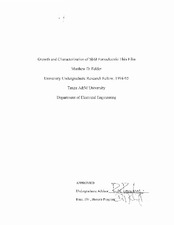| dc.description.abstract | To increase the density of memory cells in DRAM, it is desired to reduce the area of the dielectric. However, the capacitance has to meet a certain specification to store an adequate, reliable charge. A reduction in the thickness of the dielectric will compensate for the reduction in area. The cell area and thickness of the dielectric material have been stretched to the process limits in the design of the latest generation of DRAM. Intel mass produced the 4kb DRAM in 1972. Every three years a new generation of DRAM was developed that quadrupled the capacity of the previous generation. These improvements were made mainly through reduction in feature size. Following the memory generation trend, in 1993 the 64Mb DRAM was introduced. The 16Mb and 64Mb DRAMs required the use of 6 stacked or trench capacitors to achieve the necessary density of memory cells. This is an expensive method for the fabrication of the DRAMs. Future generations of DRAM (256Mb and higher) will require a new capacitive material with a higher dielectric constant. If the dielectric constant is high enough, it might be possible to eliminate stacked or trenched capacitors, thereby lowering the fabrication cost. The high dielectric constant of ferroelectric materials makes them an ideal candidate for this new generation of DRAM cells. Figure 5 shows that the dielectric permittivity in a ferroelectric material is strongly dependent on the temperature. Although the peak dielectric permittivity is at the Curie temperature, for reliability it is desired to operate well above the Curie temperature, in the paraelectric phase. | en |


